Seven Bridge is a Rummy type game which originated in Japan and is
quite popular in that country. Despite
the name of the game, it bears no resemblance to the game Contract Bridge. Other names this game is known under are Seven Rummy and Ma Jan Bridge.
Seven Bridge is designed for play by two to five players and uses one standard 52 card deck. The ranking of the cards in this deck are as follows (from high to low): King, Queen, Jack, 10, 9, 8, 7, 6, 5, 4, 3, 2, Ace. As will be noticed, the Ace is considered low but not high, and thus in a Sequence meld containing an Ace, the Ace must be the lowest card in that meld.
Determination of seating positions and first dealer can be performed in a variety of methods, including draw for low cards from the deck. Each player would draw one card from a face-down shuffled deck and the players take a choice of remaining seats at the table in the order of cards drawn from lowest to highest. The player drawing the lowest card of all is set as the first dealer.
Once the players are seated the deck is then thoroughly shuffled by the dealer and cut by the player at the dealer's immediate right. After the cut, the dealer then begins dealing in a clockwise direction around the table, starting with the player at his left. He deals each card face down to the table in front of the player to receive that card. He continues dealing until each player has a total of seven cards. He then places the remainder of the deck in a face-down pile in the center of the table.
This stack is known as the talon from which a player may draw from during
his turn. He then takes the top card from the discard pile and sets it face-up beside the talon to start the discard pile.
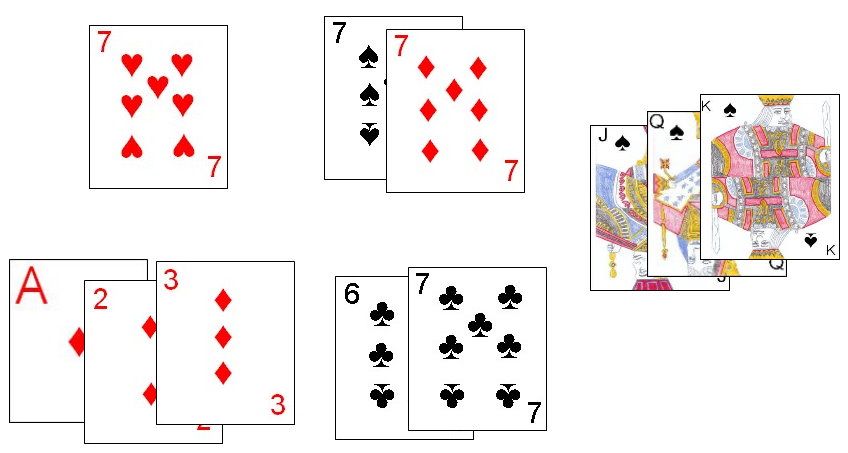 |
| Several examples of legal melds in the Rummy
type card game Seven Bridge |
As in most games of the Rummy family, the players are attempting to reduce the cards in the hand by playing them to a series of melds. To that end, the types of melds in this game are as follows:
- Sequence:
A sequence meld is one consisting of three or more cards all of the same suit and in direct sequential order (such as Jack, Queen, King of Spades).
- Group:
A group meld is a meld consisting of three or more cards all of the exact same denomination.
As will be noticed from the meld descriptions, a meld must contain at
least three cards to be considered a valid meld which can be played to
the table. However, the cards of denomination seven are an exception to
this rule. In this game, any meld containing a seven is allowed. Thus, a
solitary seven could be played as a valid meld, a sequence meld
consisting of two cards (one being a seven) is considered valid and a meld
consisting of two sevens is
also allowed. And of course, any meld of three cards or more is allowed, which can contain sevens.
Any specific card can only be used in one meld.
The player to the immediate right of the dealer has the first turn and the order of turns rotates in a clockwise direction around the table. A player's turn consists of several actions:
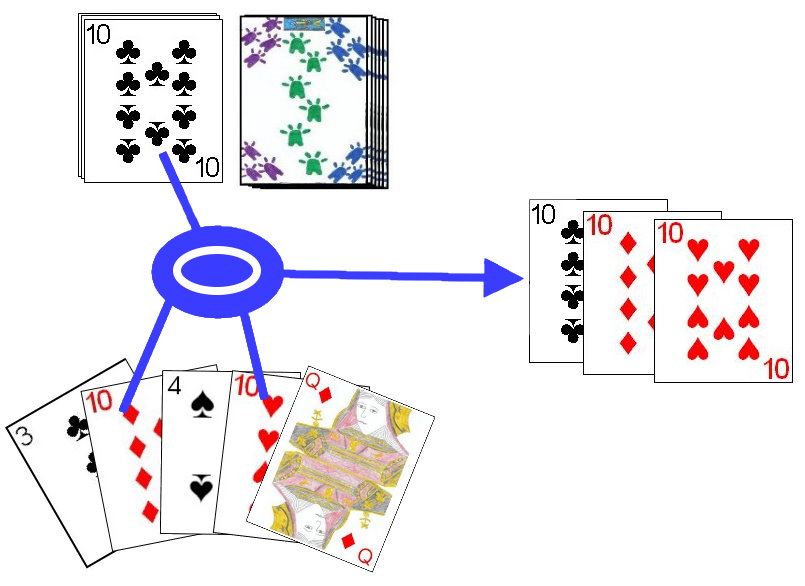
First, the player draws a card, usually the top,
face-down card from the draw pile. However, in certain cases the player may instead opt to take the top card from the discard pile. If a player draws the top card from the discard pile he may not discard that same card at the end of the same turn. There are a few specific conditions in which a player is entitled to draw this top card from the discard pile instead of drawing from the top of the stock pile.
If a player can use that top card from the discard pile with two other cards currently found in his hand to immediately make a
new meld, he may do so, placing that meld face-up on the table. If this card is used with two or more other cards to form a
sequence meld, this is called Chî. If the card is used with two or more cards from the player's hand to create a set meld, this is called Pons. A player may never take the top card from the discard pile on his first turn of the hand.
A player may also opt to take another player's discard even when not his own turn. He can only do this for a Pons meld (making a set meld) and must declare
"Pons" when doing so. If a player exercises this option, the turn moves to the player making the call, who draws the discarded card, makes a meld containing that card and then discards another card from his hand as normal. The turn then continues
to the next player, clockwise from the player who requested the discard.
After drawing the player may optionally create any legal melds on the table. The possible meld types are described above. In addition to creating a new meld, a player may lay off cards on existing melds on the table, either his own or those made by other players. A player may not lay off cards on any melds until he has made at least one legal meld to the table.
After optionally playing any cards to the table as new melds or extending existing melds, the player then completes his turn by discarding any one card of his choice from his hand to the top of the discard pile.
The game continues until a player, on his turn, manages to meld all but one card from his hand, which would be used as his discard. At this point, the sum of all cards remaining in other player's hands is accumulated to the player who first was able to play his last card in this hand and these points are added to that player's ongoing game score. Each card in the deck has a point value as shown on the following chart:
| Card | Point Scoring Value |
|---|
| 7 | 20 |
| King, Queen, Jack | 10 |
| 2, 3, 4, 5, 6, 8, 9, 10 | Value Marked on Card |
| Ace | 1 |
Any cards melded by the players are not added to the winner of the hands score, but any cards still remaining in the hands of the opponents (whether they can be formed into valid melds or not) are added to the hand winners score. If the winner of the hand melds all seven cards from his hand at the same time (having made no prior melds during the hand) he scores double for all card points found in other player's hands.
The game can be played until one player reaches a set number of points or, after a set amount of time or number of hands, the overall winner would be the player with the highest grand total in accumulated scores over the course of all hands played during the session.
No Discard Required: One variant which is sometimes played is that a player need not discard on his last turn. In the standard version
of the game, a player must discard his final card of his hand to win the hand. However, in this variant, a player could also legally play his last card of the hand as part of a new meld or laying off on an existing meld on the table.
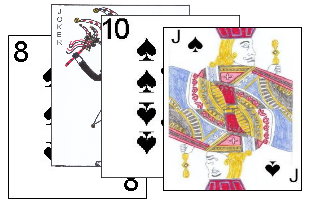 Jokers
Jokers: Some players prefer to add one Joker to the deck used in playing Seven Bridge. In this variant, the Joker may be used by a player as a substitute as any other one card. Although it may be used to replace a seven as part of a meld, the Joker does not have the special capabilities of a card of denomination seven in that it can reduce the number of cards required in a meld below three. Once played as part of a meld the Joker may not be moved or added back into any player's hand. Although a Joker has no card point value itself, it multiplies the total card point value of the hand by five when calculating the total value of card points found to be left
remaining in that player's hand.
Hoola: Hoola is a game which is similar to
Seven Bridge and appears to have been derived from it. The game was
first developed in Korea and is very popular in that country and the surrounding area.
Similar to the parent game, Hoola is designed for two to five players. Hoola uses one standard 52 card deck. The ranking of the cards in the deck to be used for playing this game are as follows (from high to low); Ace, King, Queen, Jack, 10, 9, 8, 7, 6, 5, 4, 3, 2, Ace. It should be noted that Aces are both high and low which means a sequence meld can contain an Ace as the highest card (after King), the lowest card (before two), or even in the middle (an around the corner sequence meld such as (King, Ace, two).
Determination of first dealer and seating positions can be performed using a variety of methods, with draw for low cards a common method. Each player would draw a card from the shuffled, face-down deck and the players would take a seat at the table in the order of cards drawn from lowest to highest. The player drawing the lowest card of all would be set as the first dealer for the first hand. Thereafter, the winner of each hand would deal the next.
The dealer should thoroughly shuffle the cards and offer the deck to the player at his left to cut. After the cut, the dealer then begins dealing the cards in a counter-clockwise direction around the table, one face-down card at a time starting with the player at his right. He continues dealing until each player has a total of seven cards. He then places the remainder of the deck face-down in a stack in the center of the table, taking the top card from this stack and placing it face-up beside the stack to start the discard pile.
The object of Hoola is to be the first player to manage to form all cards in the hand into legal melds. The allowable melds in Hoola are as follows:
- Sequence:
A sequence meld is one consisting of three or more cards in sequential order which are all of the same suit (such as 8, 9, 10 all in the suit of Diamonds).
- Set:
A Set meld is a meld consisting of three or more cards of the exact same denomination
(such as the 10 of spades, 10 of Diamonds and the 10 of Clubs).
A meld of either type must consist of at least three cards with the exception of a meld which contains a seven. A meld containing a seven can contain any number of cards (in fact, a single seven is considered a valid meld).
The player to the immediate right of the dealer has the first turn, and the turn rotates in a counter-clockwise direction around the table. On his turn a player performs several actions:
- To begin his turn, a player first must draw a card. He may either draw the top face-down card of the stock pile or the top face-up card from the discard pile. A player may only take the top card from the discard pile, however, if he can immediately use this card in a valid, new meld to the table. He may never add the card directly into his hand nor use it to extend an existing meld already on the table.
- After drawing, the player may next make melds to the table from the cards in his hand. If he has any complete melds he may (but is not required to) place these melds on the table in front of himself (called dropping a trick). He may also extend other melds already found on the table (made by himself or other players), called adding to a trick. A player may only extend existing melds if he has first made at least one complete meld to the table on this same hand.
- To complete his turn a player then discards one card face-up to the top of the discard pile from his hand.
Normally the turn would then move to the next player in a counter-clockwise direction. However, if any player, even if not his turn, wants to take the last discard he has the right to claim it. He does this by slapping his hand on the card in the discard pile. If multiple players want to take the card out of turn, the first player to so slap the card has the right to take it. After claiming the card in this way, the player also states "Kam sa hap nida!" (Thank you! in Korean) and places the card on the table with other cards from his hand to form a new, legal meld. This player who claimed the card then continues as if it was his normal turn, optionally making other melds and discarding at the end of his turn. The turn would then continue in a counter-clockwise direction from the player who claimed the card.
The hand continues until one player manages to win the hand. He does this by fulfilling one of the following winning conditions of a hand:
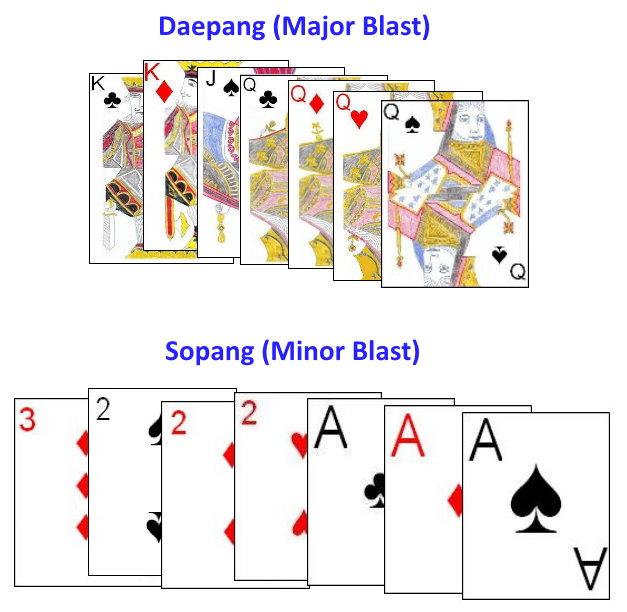 |
| Examples of a major blast and a minor blast in the game Hoola |
- Four Sevens: If a player manages to collect all four sevens in his hand he states this and immediately wins the hand. The player must have all sevens in hand, however, as any sevens played to the table cannot be used to fulfill this victory condition.
- Blast: A player can also win with a Blast. There are actually two types of Blast for which a player can win, the Major Blast (called Daepang) and the Minor Blast (called Sopang). A Major Blast is if a player manages to have a total of 83 or more card points in the hand, and a Minor Blast is when the player has 14 or fewer card points in the hand. If a player finds that he has a Major or Minor Blast on his turn, before
having melded any cards to that table on this hand, he may state this and win the hand.
- Out: If a player manages to meld all but the last of his cards on his turn, and then meld his last card, he has "gone out", winning the hand.
- Knock: If a player, at the beginning of his turn, has a total of 10 or fewer card points remaining in his hand, and at least one other player has made at least one meld to the table, a player may Knock. After knocking all players, including the knocker place the cards
remaining in hand face-up on the table. If the knocker is found to have the lowest total in card points remaining in the hand, he immediately wins the hand. However, if any other player has an equal number or less number of card points in hand, that player wins the hand instead. If multiple players have fewer card points in hand, the player with the fewest card points is the winner of that hand.
- Stock Exhausted: If the last card from the stock is drawn, the player who drew that card completes his turn, and then all players expose their unmelded cards from their hand. These players are permitted to make any melds possible from their hand and, if they have made at least one new meld during this hand, may also lay-off cards on melds made by other players. After all players have made any melds or laid off any cards possible, the player with the fewest card points remaining in hand wins the hand.
As will be noticed, most of the win conditions rely on a total count of card points. To this end, each card in the deck has a corresponding card point value. The following chart shows the card point value for each card in the deck:
| Card | Card Point Value |
|---|
| King | 13 |
| Queen | 12 |
| Jack | 11 |
| 2, 3, 4, 5, 6, 7, 8, 9, 10 | Value marked on card |
| Ace | 1 |
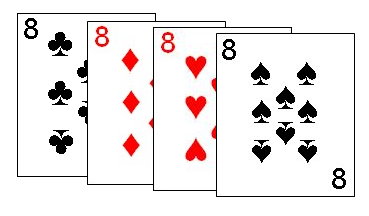
When counting points left remaining in a player's hand, any four cards of the same denomination (called a quad) still in that player's hand are discarded and count 0.
Final scoring of the hand is often done as a total of Game Points. Thus, the winner will earn a number of Game Points from each other player as follows:
The opponent of the winner with the fewest number of points must give the winner 1 Game Point. The opponent with the next fewest points must give 2 Game Points and so on for each opponent in the hand. If two or more players tie for the same number of points, they would each give the winner the same number of points, which is equivalent to the number of points the player amongst those tied would have had to give if he had more points than those other tying players.
For each seven a player is found to have
remaining in his hand, he must double the number of Game Points he must give to the winner. Likewise, a player who has had at least one turn but
has yet made no melds to the table must give double the number of expected Game Points.
If the winner managed to win the hand by melding all his cards at the same time (no previous melds), and each other player has had at least one turn during this hand, each of these opponents must give him double the number of Game Points (called a Hoola). If the winner of the hand manages to do this by taking another players discard, he collects all points won from the hand from that specific player who had discarded that card.
In the event that a player knocked, but another player was found to have an equal or lower number of card points (called an undercut), the knocking player must give double the normally earned game
points to the player with the lowest total, and all other players do not lose any points.
After a set number of hands, the player with the highest grand total of Game Points is declared the overall session winner.
Copyright © 2015
CatsAtCards.com. All rights reserved.

 First, the player draws a card, usually the top,
face-down card from the draw pile. However, in certain cases the player may instead opt to take the top card from the discard pile. If a player draws the top card from the discard pile he may not discard that same card at the end of the same turn. There are a few specific conditions in which a player is entitled to draw this top card from the discard pile instead of drawing from the top of the stock pile.
If a player can use that top card from the discard pile with two other cards currently found in his hand to immediately make a
new meld, he may do so, placing that meld face-up on the table. If this card is used with two or more other cards to form a
sequence meld, this is called Chî. If the card is used with two or more cards from the player's hand to create a set meld, this is called Pons. A player may never take the top card from the discard pile on his first turn of the hand.
A player may also opt to take another player's discard even when not his own turn. He can only do this for a Pons meld (making a set meld) and must declare
"Pons" when doing so. If a player exercises this option, the turn moves to the player making the call, who draws the discarded card, makes a meld containing that card and then discards another card from his hand as normal. The turn then continues
to the next player, clockwise from the player who requested the discard.
First, the player draws a card, usually the top,
face-down card from the draw pile. However, in certain cases the player may instead opt to take the top card from the discard pile. If a player draws the top card from the discard pile he may not discard that same card at the end of the same turn. There are a few specific conditions in which a player is entitled to draw this top card from the discard pile instead of drawing from the top of the stock pile.
If a player can use that top card from the discard pile with two other cards currently found in his hand to immediately make a
new meld, he may do so, placing that meld face-up on the table. If this card is used with two or more other cards to form a
sequence meld, this is called Chî. If the card is used with two or more cards from the player's hand to create a set meld, this is called Pons. A player may never take the top card from the discard pile on his first turn of the hand.
A player may also opt to take another player's discard even when not his own turn. He can only do this for a Pons meld (making a set meld) and must declare
"Pons" when doing so. If a player exercises this option, the turn moves to the player making the call, who draws the discarded card, makes a meld containing that card and then discards another card from his hand as normal. The turn then continues
to the next player, clockwise from the player who requested the discard.
 Jokers: Some players prefer to add one Joker to the deck used in playing Seven Bridge. In this variant, the Joker may be used by a player as a substitute as any other one card. Although it may be used to replace a seven as part of a meld, the Joker does not have the special capabilities of a card of denomination seven in that it can reduce the number of cards required in a meld below three. Once played as part of a meld the Joker may not be moved or added back into any player's hand. Although a Joker has no card point value itself, it multiplies the total card point value of the hand by five when calculating the total value of card points found to be left
remaining in that player's hand.
Jokers: Some players prefer to add one Joker to the deck used in playing Seven Bridge. In this variant, the Joker may be used by a player as a substitute as any other one card. Although it may be used to replace a seven as part of a meld, the Joker does not have the special capabilities of a card of denomination seven in that it can reduce the number of cards required in a meld below three. Once played as part of a meld the Joker may not be moved or added back into any player's hand. Although a Joker has no card point value itself, it multiplies the total card point value of the hand by five when calculating the total value of card points found to be left
remaining in that player's hand.

 When counting points left remaining in a player's hand, any four cards of the same denomination (called a quad) still in that player's hand are discarded and count 0.
When counting points left remaining in a player's hand, any four cards of the same denomination (called a quad) still in that player's hand are discarded and count 0.